Thursday 2nd to Wednesday 8th March 2017
Cruisers often act as line handlers for other boats before their own boat goes through the Panama Canal so that you’ve got a better idea of the procedures involved, and we were pleased to help friends Terry and Carol in their boat Little Dove a few days before Vega was due to go through. Each yacht must have a skipper and four line handlers who can either be arranged by the agent (and paid for at the rate of US$100 per person) or can be other cruisers. In addition an Advisor comes on board to supervise the transit. The Advisor is usually someone who works for the canal authority and does this in his spare time for extra money. The Advisor, skipper and line-handlers must be kept happy with regular meals, snacks, water and cold drinks.
Little Dove motored away from the marina and across Colón harbour, where there are many large cargo ships at anchor awaiting their turn to transit the canal. We hung around in ‘the Flats’, a small vessels anchorage area, for our Advisor to come aboard from his motor launch, then, once he’d manage to leap on deck in the big swell, we headed off towards the Gatun Locks, following a larger yacht ‘Let it be’ past some cargo ships exiting the canal and past the new concrete bridge being built over the harbour.
As we headed towards the first set of locks we got to know our Advisor, Victor, a cheerful, lanky man in his 60s who worked full time in security for the Canal, and had seven children aged from 3 to 39.
Just outside the entrance to the Gatun Locks we tied up to Let it be with another smaller yacht, Gegenwind, on the other side. Let it Be as the larger central boat was to be the driving force of the raft of three yachts with long lines going from the bow and stern of each of the two smaller yachts to hold the raft in place in the lock. Hugh and I were line handling at the bow of Little Dove with Thom (a single-handed sailor who we’d first met in Santa Marta) at the stern. As we approached the wall of the first lock high above us, the Canal linehandler threw us a heavy ‘monkey fist’, a lead ball knocked round with rope, which you had to grab as it came flying over, whilst trying to avoid getting hit by it yourself, and to which was attached a thin messenger line. We tied the end of this thin line to a loop in our heavy blue line and as the raft moved slowly forward in the lock we held up our end of the thin line as the linehandler on the lock wall walked forward with his. Once we were in position, close behind the big cargo ship ahead of us in the lock, the linehandler hauled up our blue line and dropped the loop in it round a huge bollard on the lock wall. We then pulled our end of the blue line taut around the cleat on the bow of Little Dove to stabilise the raft.
Once the lock gates closed the water rushed in and the water level rose, so we had to repeatedly haul on the heavy blue line to take up any slack and to prevent the boats on either side from swinging against the walls of the lock in the turbulence. Once the lock had filled, which took about 15 minutes, the gates in front opened, the cargo ship moved on and we followed after pulling our heavy blue lines back on board Little Dove whilst still remaining connected to land by the thin lines. In the second and third of the series of three locks the procedure was repeated until just before the final gate opened when we untied the thin line from the end of our blue line and moved on into the Gatun Lake. We had been raised a total of 26 meters in the three locks. Here we unrafted and motored in the dark a short way only to tie up again onto Let it be, itself moored onto a huge buoy. Victor was collected by motor launch and headed off home. We were pretty exhausted by now and were in need of the beers, G&Ts, wine and chicken casserole provided by Carol. They put us up in their bow cabin and Thom slept on deck.
We had to be up early the next morning as our new Advisor was due to arrive at 7am. He was Francisco, young, good-looking in well-ironed grey t-shirt and, even more laid-back than Victor, he spent most of the day on his mobile phone, texting.
The next stage of the transit was to motor the 20 miles through Gatun Lake, maintaining a constant distance from the yacht ahead of us and well to the edge of the buoyed channel out of the way of oncoming cargo ships. We sat at the back of Little Dove, sheltering from the sun under the awning, chatting and watching the big ships pass and the low tree covered islands protruding above the surface of the water. Carol provided sausages for breakfast then cake and watermelon to keep us happy on the 4 hour trip through the lake. We kept a look out for the crocodiles that we know live in the lake and the monkeys and birds that live in the wild, uninhabited forest on the shores of the lake. It was disappointing to see so little.
At one point we passed the Smithsonian Tropical Research Institute in Laboratory Cove in the lake, which conducts research into such things as dying coral reefs and collecting sperm from endangered Panamanian Golden Frogs.
Then through the Culebra Cut, an 8 mile long section which required the majority of the excavation work when the canal was built. There is ongoing work here to dredge the channel and reinforce the canal banks and it is also being widened to allow for bigger vessels to transit simultaneously in opposite directions.
After passing under the Centennial Bridge we had three more locks to pass through, Pedro Miguel Lock then after motoring for a mile through the Miraflores Lake, the final two Miraflores locks. It was much the same procedure but easing the lines as the water rushed out of the locks and we descended.
In the final lock there was a visitors centre with tourists crowding the balconies, watching our progress.
Once through the final lock we untied to Let it Be and continued on, under the Bridge of the Americas and to the Balboa Yacht Club where Carol and Terry planned to stay for a few days tied to a buoy. We caught a taxi back to Shelter Bay Marina in time for supper.
We made a final trip to the supermarket to stock up with perishables and in the afternoon Tom, another Ambling Band friend, arrived from the UK via Bogotá and Panama City to join us for the trip to the Galápagos. Our agent dropped off the four 125 ft blue lines and six extra large fenders to protect the boat from damage in the canal.
Then it was Vega’s turn to transit. In the morning I cooked a big chicken stew for supper, taking a lead from Carol, and at 1pm we headed out towards The Flats. As we left the marina and motored out across the harbour we passed a rather elegant classic yacht which we were told had been restored and refurbished by James Dyson.
Our Advisor for the first day was Moisés, who enjoyed Hugh’s question ‘now tell us, have you ever done this before, as we have?’ and showed us pictures of his wife and children.
Our transit followed much the same procedure as for Little Dove, only Hugh was skipper and I was in charge of the catering – much less relaxing! We were both a bit nervous and glad we’d been through the routine once already. Friends Ian and Steph were line handling on the bow, with Tom and myself on the stern line. We rafted up with a large catamaran Jadean in the centre which would be responsible for keeping the three boats moving steadily and straight.
Moisés seemed to enjoy my chicken stew and we were all shattered by the time we were through the first set of locks, tied up to a buoy for the night and able to relax in the cockpit and eat supper ourselves.
We had Omar as Advisor on the second day who clearly found it a completely exhausting task trying to ensure that we kept at exactly the precise distance from passing buoys and the yacht ahead as we motored through Gatun Lake.
At the Miraflores Locks we had a long wait as the US naval supply ship, 2nd. LT. JOHN P. POBO, had been delayed. Eventually it arrived and was towed in by electric mules on either side of the canal.
As we waited in the last lock we celebrated by waving the pink Ambling flag – hoping that it would help family and friends to see us on the webcam. It was wonderful to know that several did and we exchanged text messages. Then out of the final lock and Vega was in the Pacific Ocean!
We tied up on one of the Balboa Yacht club buoys, said a grateful thanks to Ian and Steph as they headed off in the dark to get a taxi back to Shelter Bay (we would be seeing them soon in the Galápagos) and spoke briefly to Terry and Carol who were due to leave the following morning for Ecuador via Las Perlas islands. After a day in Panama City visiting the local fruit and vegetable markets we headed off ourselves towards Las Perlas and then on across the Pacific Ocean for the 850nm trip to the Galápagos.
Some facts about the Panama Canal:
Although it was first attempted by the French, completed by the Americans and is now controlled by Panama, the Panama Canal was actually the brainchild of King Charles V of Spain in the early 1500’s.
France was the first country to attempt construction and planned to build a sea-level canal through Panama in 1881. The same company that had built the sea-level Suez Canal so successfully was awarded the contract. However, due to engineering problems, tropical rains and floods, jungle full of venomous snakes and spiders and a high worker mortality rate from malaria and yellow fever, they went bankrupt and abandoned the project in 1889.
The United States were determined that a canal was vital and began negotiating the rights to build one with the Colombian Government when Panama was still under Colombian rule. When negotiations fell through (according to President Roosevelt the Colombian Government were too greedy and reluctant to relinquish sovereignty of the land needed), the US Government encouraged the Panamanians to revolt and declare independence from Colombia. Panama declared its independence on November 3, 1903, and the naval ship USS Nashville was deployed to prevent Colombia from interfering.
When the US gained control of the canal project they decided, after extensive engineering studies, to build a canal with locks. They started construction on the Panama Canal in 1904 and completed it ten years later in 1914.
The United States spent nearly $400 million on the Panama Canal. With inflation, that figure today is over $8.5 billion.
The US operated the Panama Canal from its opening in 1914 until 1999 when full control of the Canal was handed over to Panama.
The canal is 48 miles (77.1km) long. If a ship had to travel down and around the southern tip of South America they would have to travel 20,000km. It takes ships around eight to ten hours to pass through the canal compared to 2 weeks if a ship had to travel around South America by the lengthy, hazardous Cape Horn route.
Over one million vessels have passed through the canal since it opened. The 1,000,000th ship to pass through the Panama Canal was the Chinese freighter the Fortune Plum on September 4th, 2010.
The Panama Canal operates using a system of 3 locks, the Gatun Locks on the Atlantic side and the Miraflores and Pedro Miguel Locks on the Pacific Side. The Miraflores Locks have two chambers, the Pedro Miguel Locks have one, and the Gatun Locks have three chambers. The locks raise and lower the ships from sea level in order to travel the Gatun Lake.
The locks use the original gates that have been operational since the Canal’s opening in 1914.
Gatun Lake is an artificial lake, created to reduce the amount of excavation work required for the canal, 26 metres (85 ft) above sea level and formed by damning the Chagres River near to its outflow into the Caribbean.
Ships are charged a toll based on their type, size and cargo. The average toll for a ship to travel the canal is $150,000.
Vega’s toll for our transit was US $800 and we had to share locks with other yachts and a larger ship, since it is not economical for the locks to be operated for this cost. With agent’s fee, boat inspection, security fee, fender and line hire, check-out, bank charges and cruising permit our total cost was $1,709.
The cheapest toll ever paid to travel the canal was 36 cents paid by Richard Halliburton, an American adventurer, who swam the length of the canal in 1928. He had to pay a toll based on his weight and water displacement.
The most expensive regular toll was paid by the MOL Benefactor, a 10,000 container cargo ship which paid $829,468 to transit the new locks system in 2016.
The fastest transit was completed in 2 hours 41 minutes by the U.S. Navy’s Hydrofoil Pegasus in 1979.
Annual traffic has risen from about 1,000 ships in 1914, when the canal opened, to about 15,000 a year i.e. about 40 to 50 per day.
The Panama Canal takes in about $2 billion a year in revenue, and approximately $800 million goes into Panama’s General Treasury each year.
Only Panama Canal Pilots working with the Panama Canal Authority are able to captain a boat through the Panama Canal. When a ship enters the canal, they are boarded by a pilot, who has full control over the boat until it exits the canal.
The size of the locks determines the maximum size of a ship that can pass through them. Ships specifically built to the largest specifications possible to transit the original locks of the canal are called Panamax ships. They can be a maximum of 950 ft long, 106 ft wide, and hold the equivalent of 5,000 20 ft shipping containers (TEU).
A third, wider lane of locks was constructed between September 2007 and May 2016.They operate simultaneously with the original set of locks and are able to accommodate ships over twice as large (13,000 TEU vs. 5,000 TEU) – ships which adhere to the “New Panamax” standards.
The new locks had their first transit on Saturday, June 26th, 2016.
The widened Panama Canal will still be smaller than some of the world’s largest container ships.
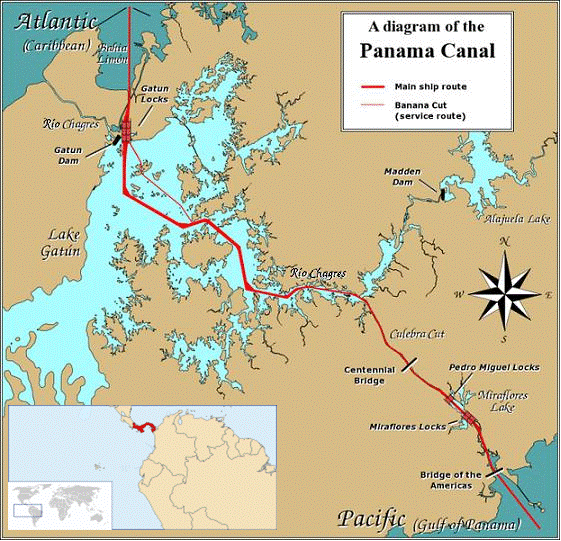
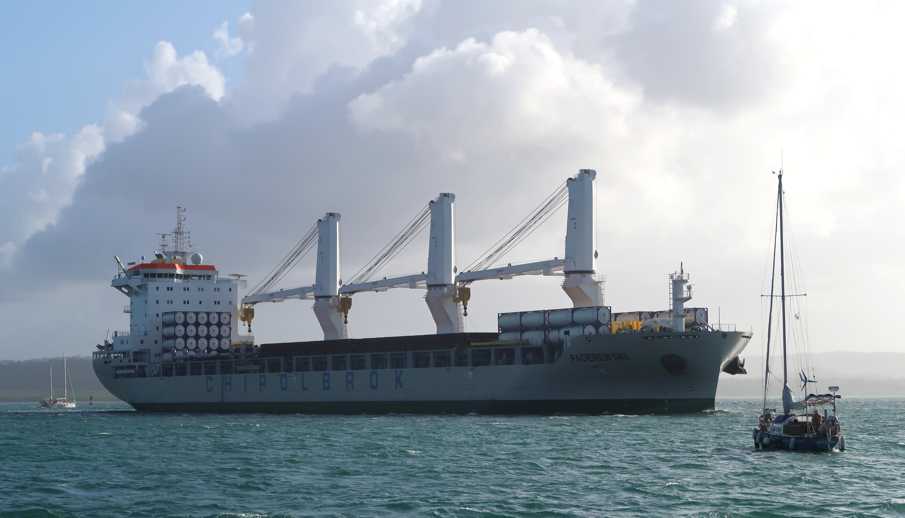
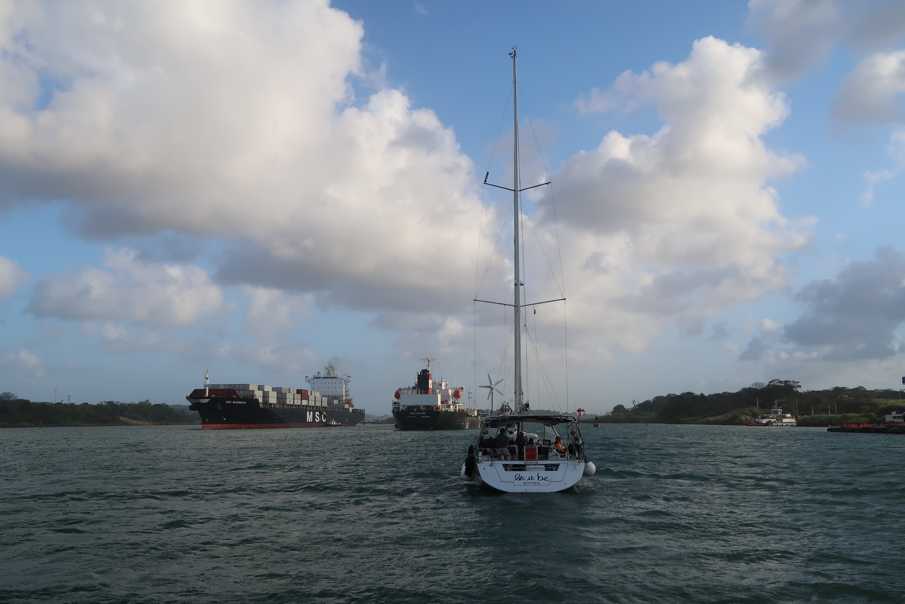

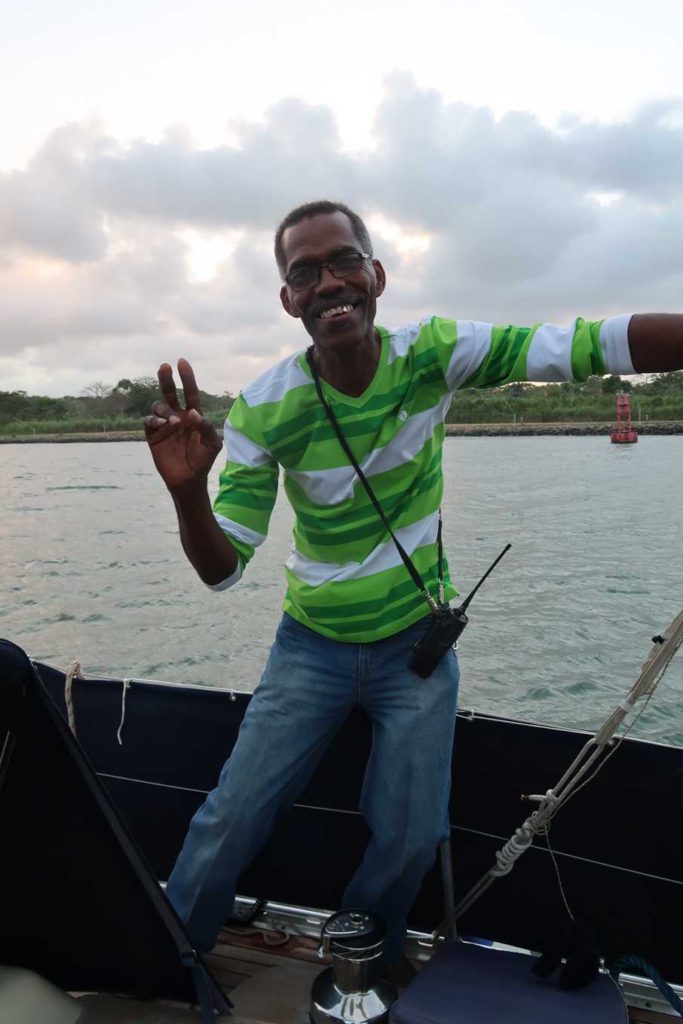

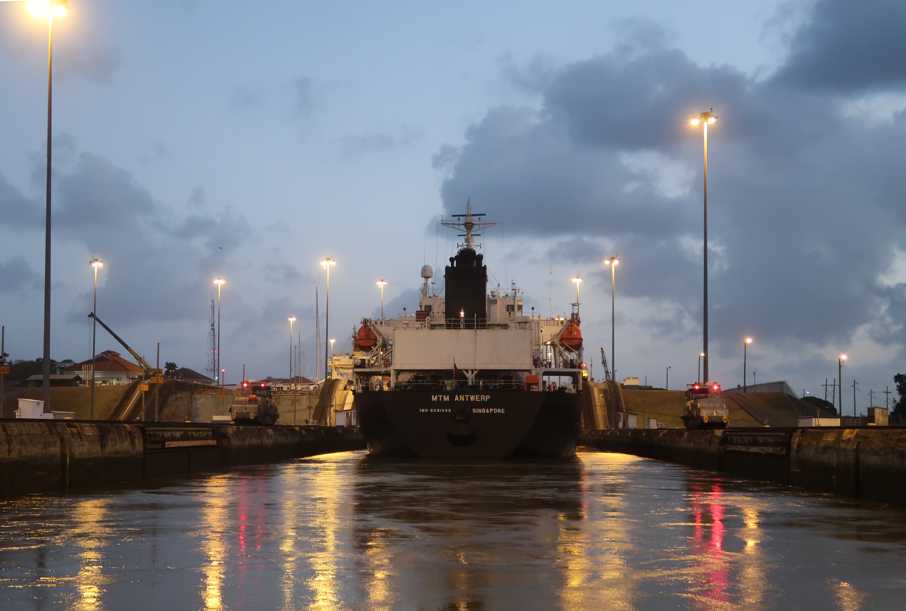
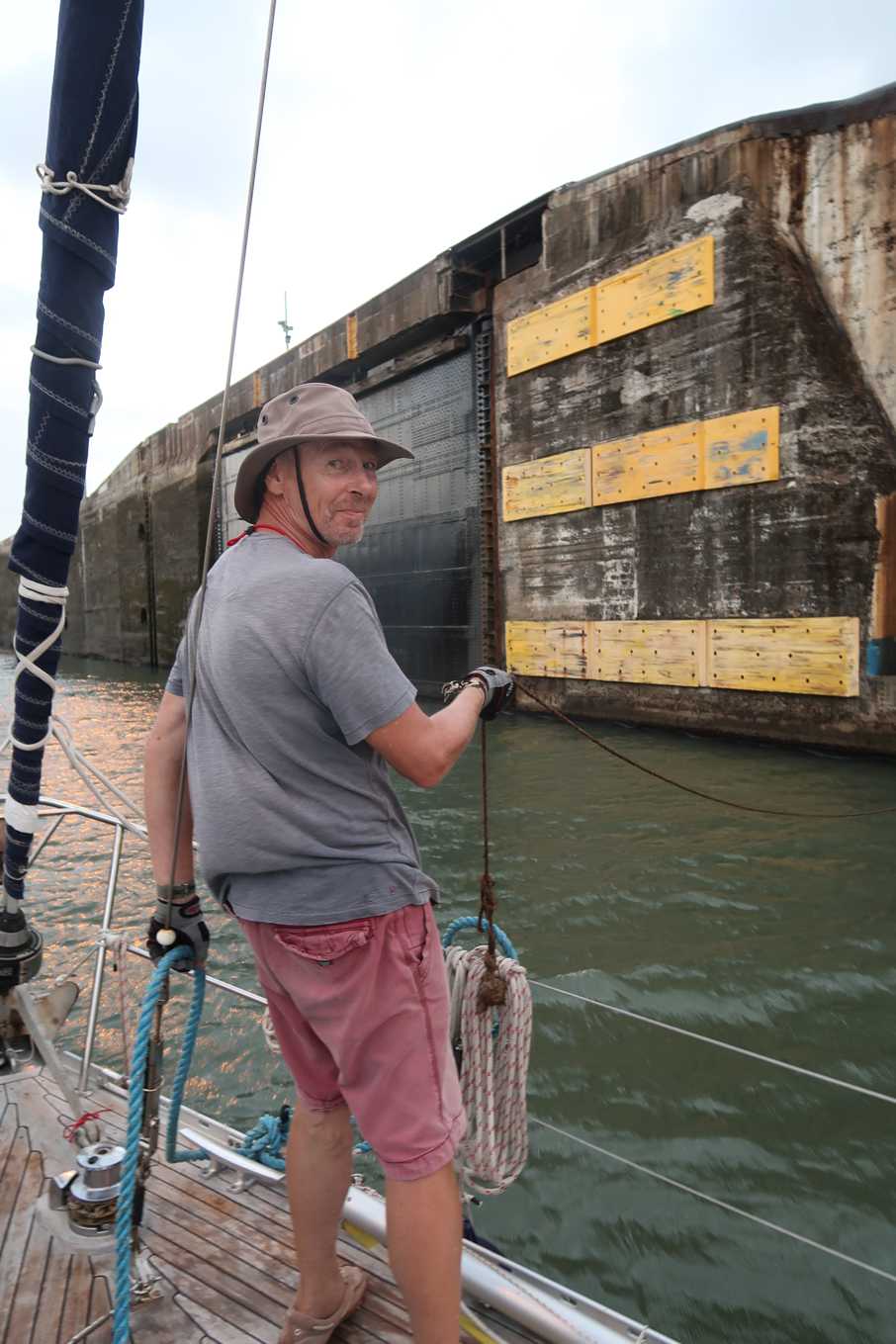




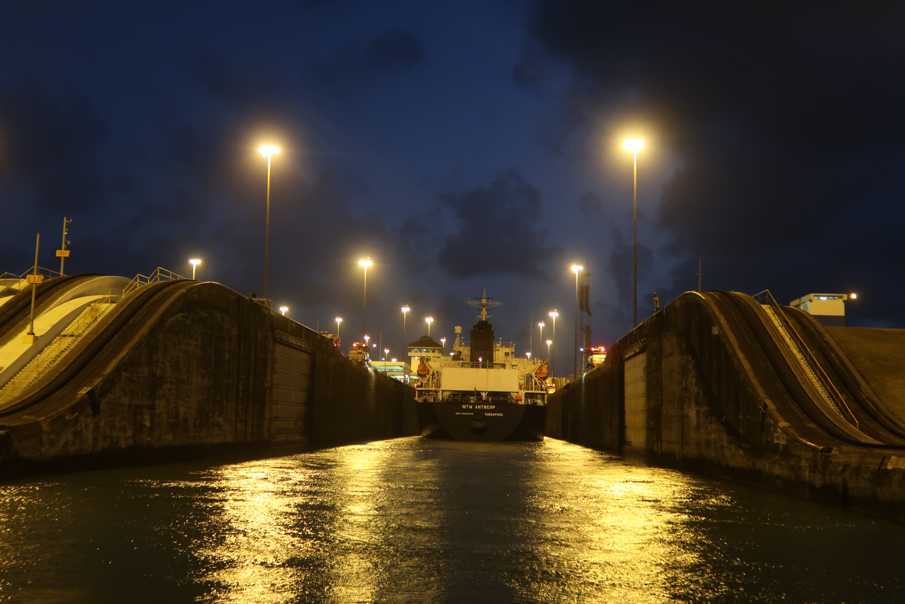
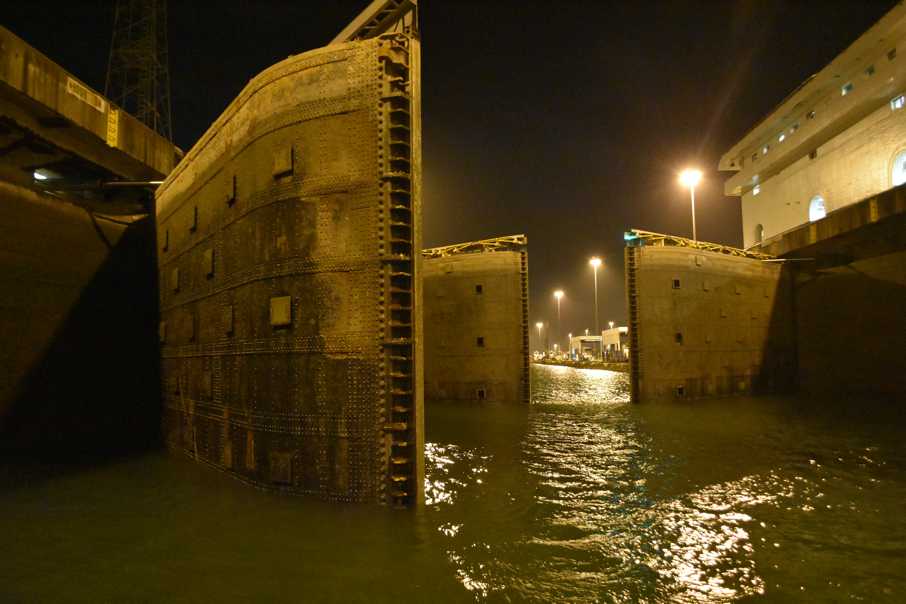
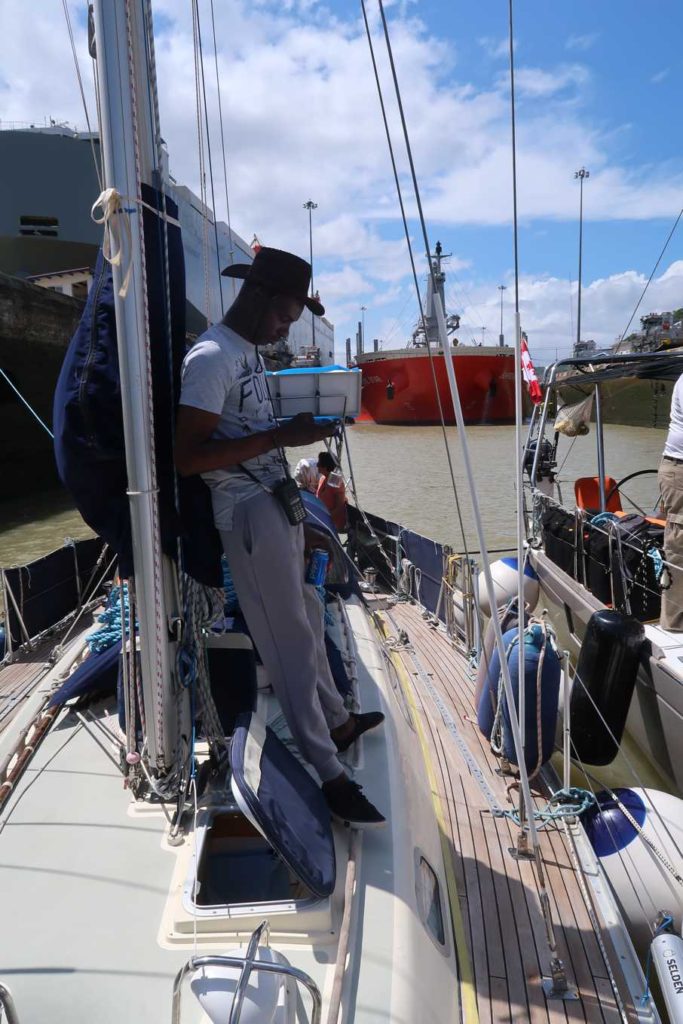

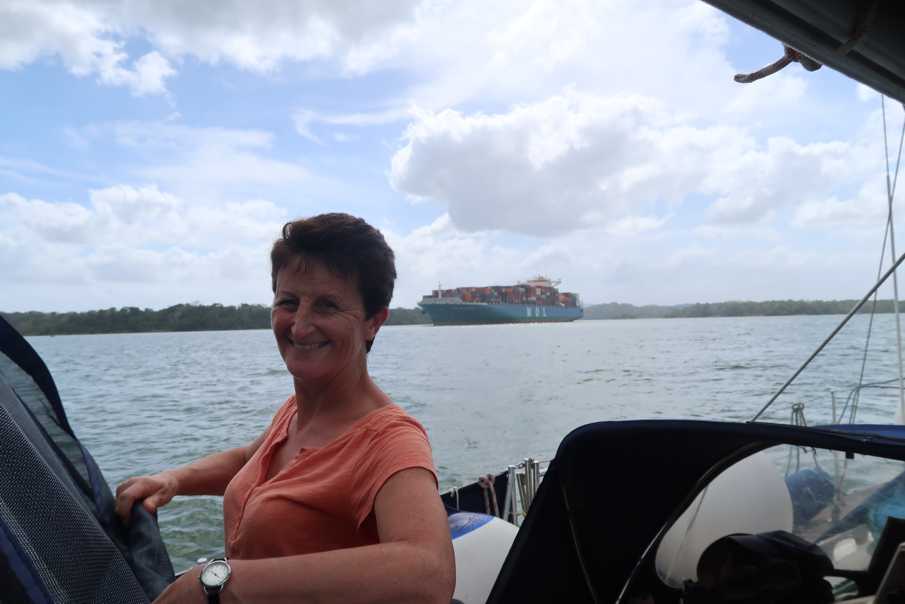
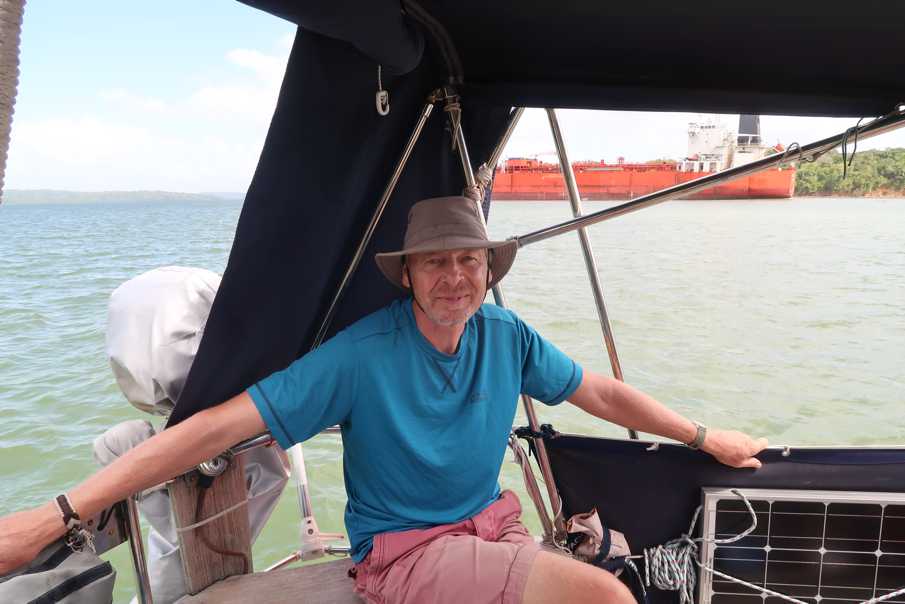



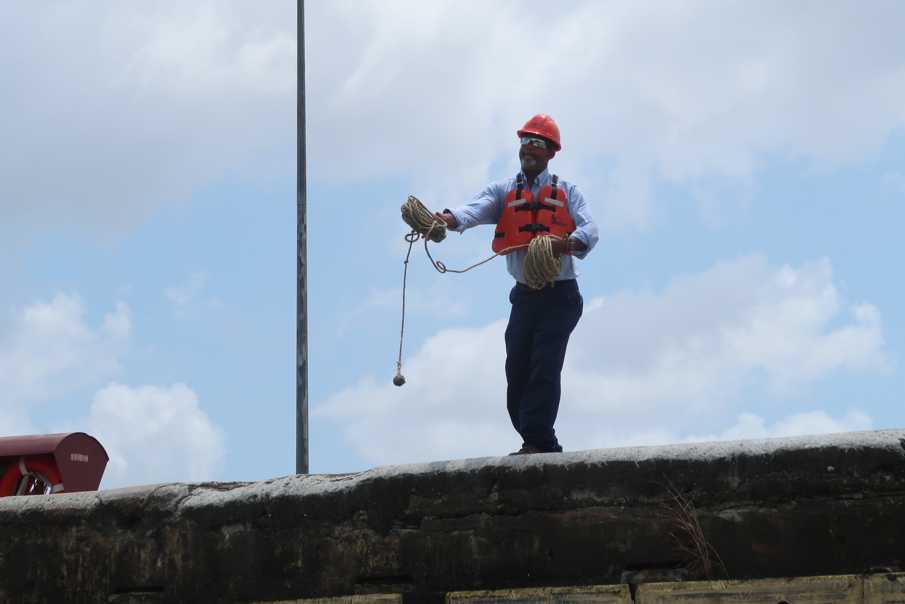


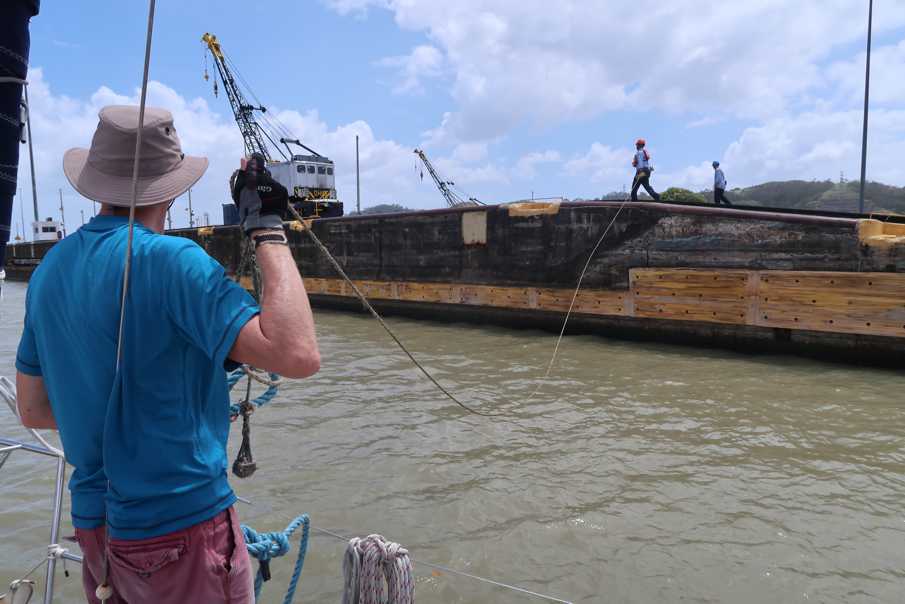
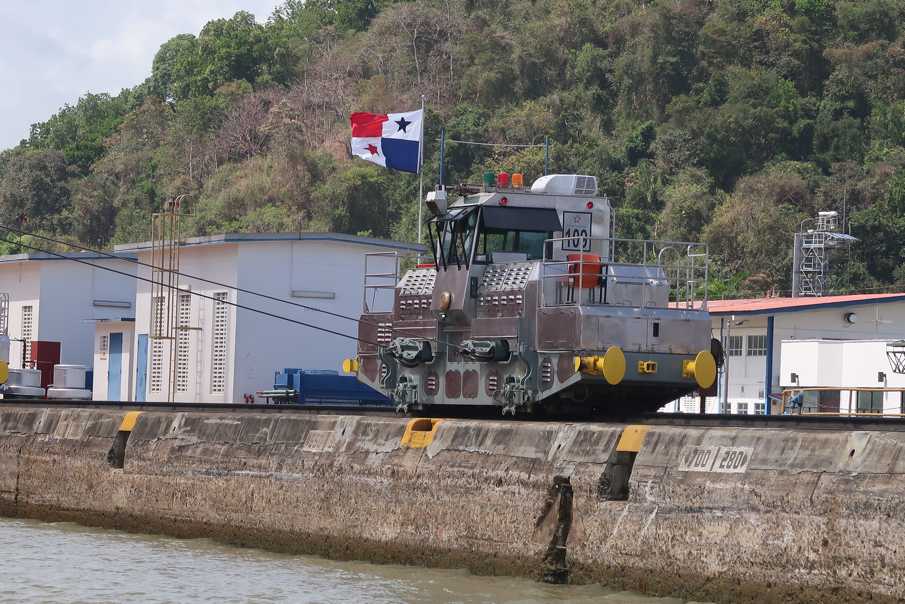






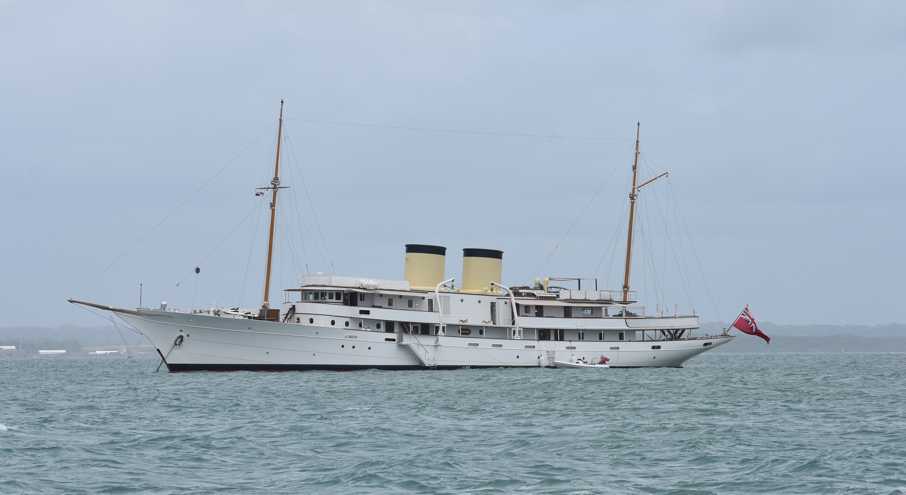
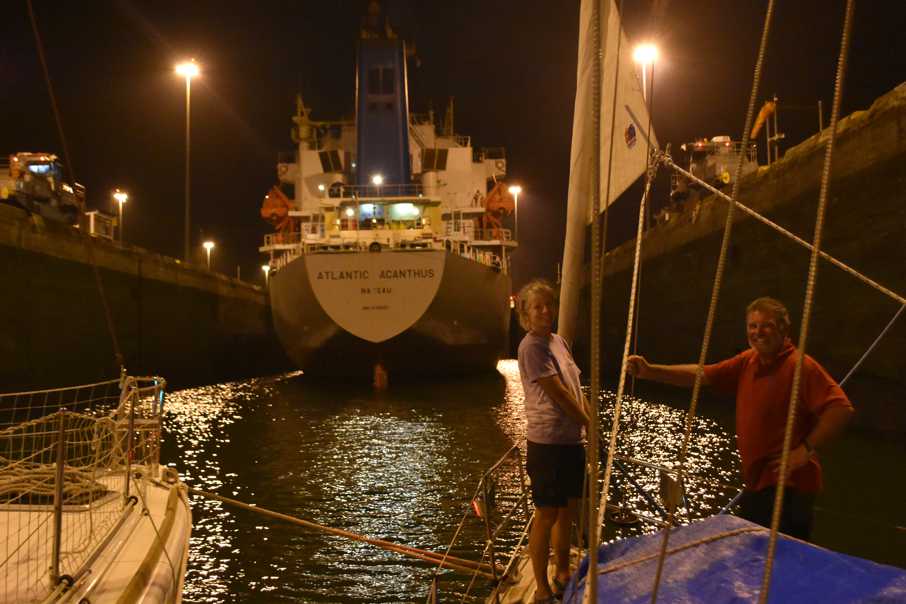
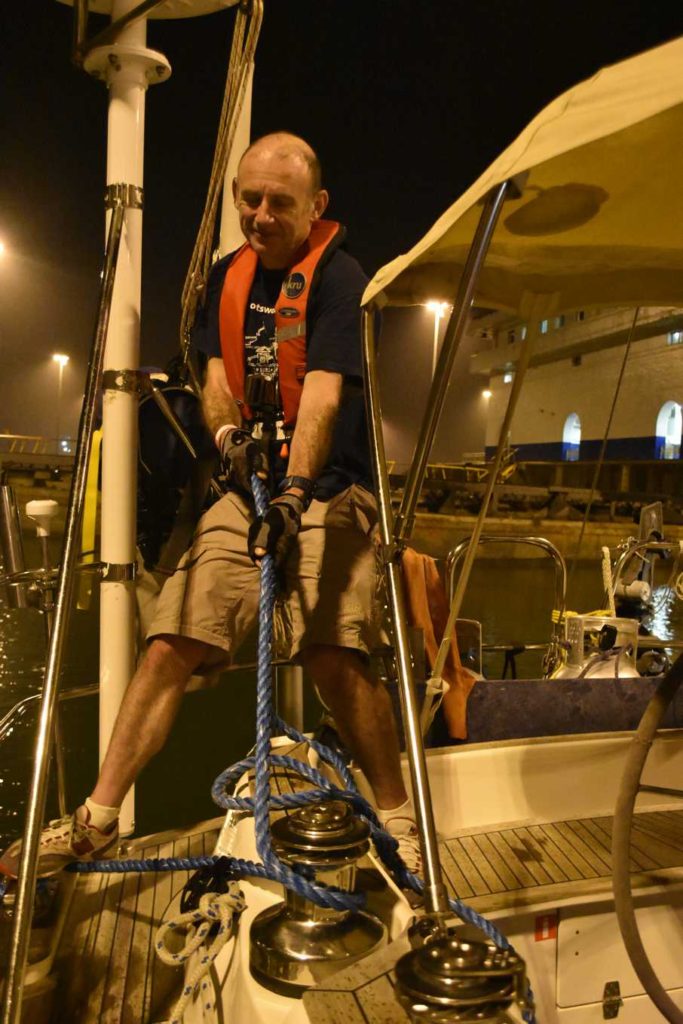
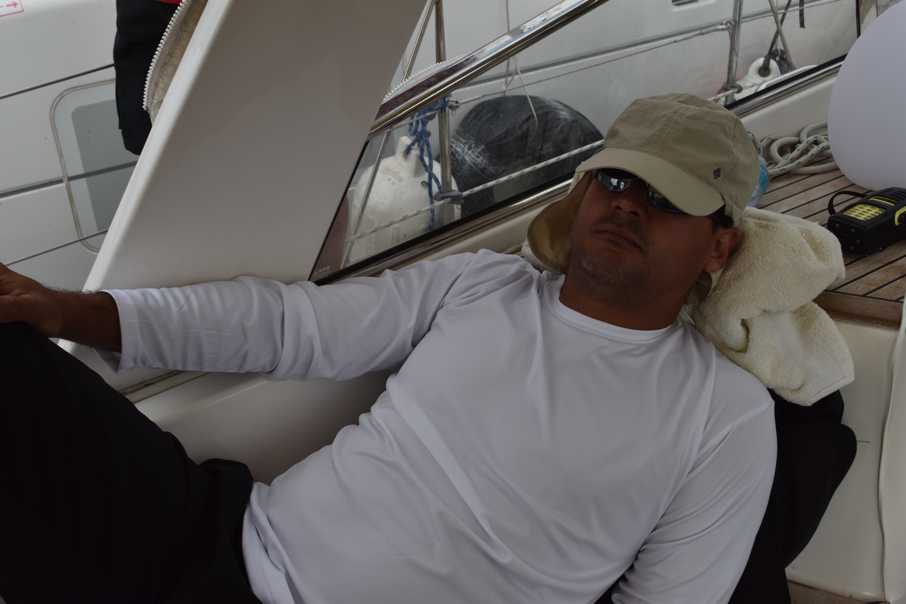
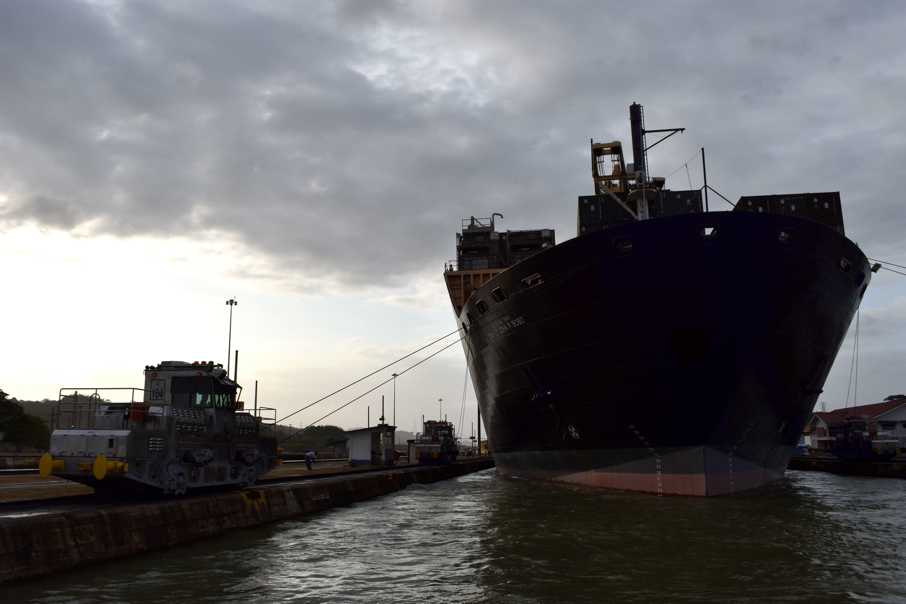
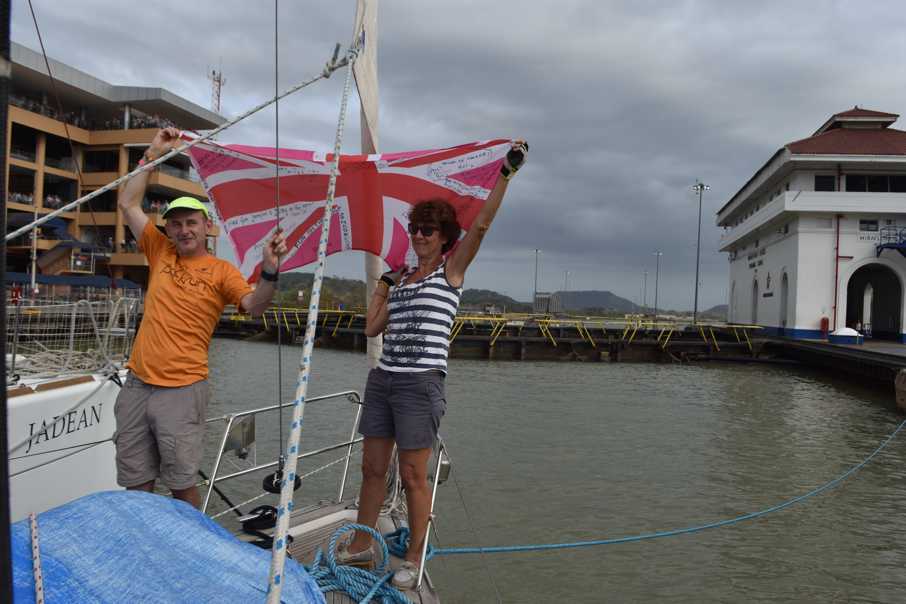
6 Comments
Jerry
April 2, 2017 - 3:34 amOr how about the 12” extended remix version – A man, a plan, a canoe, pasta, heros, rajahs, a coloratura, maps, snipe, percale, macaroni, a gag, a banana bag, a tan, a tag, a banana bag again (or a camel), a crepe, pins, Spam, a rut, a Rolo, cash, a jar, sore hats, a peon, a canal – Panama! Jerry xx
annie
April 6, 2017 - 6:23 pmThanks for your much more interesting suggestion Jerry. Will change the title when I get a moment xx
Gerard Smart
April 2, 2017 - 1:42 pmWhat an experience cannot wait for Galapagos photos.
Followed the trip via your AIS on FIND SHIP App which strangely now shows you just off Panama dated 29/3
Regards
Gerard
annie
April 6, 2017 - 6:24 pmWe are in the Galapagos, really. Will get the captain to look into this x
Alieu
April 21, 2017 - 1:40 pmI wish u good explore,much more important.Annie strong woman,captain Hugh good voyage
annie
May 26, 2017 - 1:02 amHello Alieu. Thanks for your good wishes and hello to your family in The Gambia. Hugh and Annie